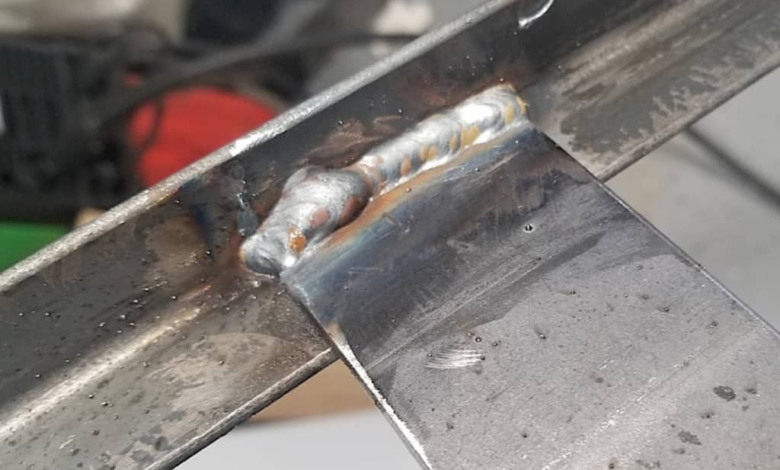What Metal To Be Welded Should Be Tack Welded In?

Tack welding is essential because it provides temporary holds to align and secure metal components before the final weld is done. This first phase ensures that the parts remain in their intended positions throughout welding, preventing deformation or misalignment that could affect the final weld. However, not all metals are ideal for tack welding. The metal used determines the tack weld’s effectiveness and the finished junction’s overall strength. Metal thickness, composition, and welding procedure all impact which metals are best suited for tack welding.
This guide lists the most suitable metals for tack welding and the key considerations for selecting these metals.
What Is Tack Weld?
Tack welding is a technique used in the early stages of welding to join metal parts temporarily. It involves small, localised welds placed at regular intervals around the margins of metal components. A tack weld’s principal function is to retain the alignment and location of the welded elements, preventing them from shifting or moving during the final welding process. This temporary bond is strong enough to hold the components in place but can be changed or removed.
Tack welds are essential in cases requiring precise alignment because they allow the welder to make modifications before resulting in a complete weld. They are especially handy in complex assemblies or when working with huge, heavy components that are difficult to move.
What Metal To Be Welded Should Be Tack Welded In?
Tack welding can be used with various metals. However, it is essential to consider your project’s requirements and the properties of the metal. Here are the common metals that can be used:
Steel
Steel is the most commonly tack welded metal in various forms due to its vast application in the construction and automotive manufacturing industries. Carbon steel is popular because it is affordable, accessible to work with, and behaves predictably under heat. Tack welding carbon steel is simple, and the metal’s high thermal conductivity ensures that the tack welds adhere strongly. This keeps the components aligned until the final weld tack is completed.
Stainless steel, recognised for its corrosion resistance, is also an excellent choice for tack welding. However, while tack welding stainless steel, it is important to consider thermal expansion and contraction issues. If not managed correctly, these can cause warping or distortion. Tack welds in stainless steel should be applied carefully to prevent the introduction of contaminants that could compromise the metal’s corrosion resistance.
Alloy steel contains additional elements like chromium, nickel, or molybdenum to enhance its properties. The presence of these alloying elements can affect how the metal behaves under heat, so it is essential to adjust the tack welding technique accordingly. With the correct approach, tack welding can effectively stabilize alloy steel parts before the final weld.
Aluminum
Aluminum’s physical qualities make it difficult to tack weld. It has a high thermal conductivity, which means it distributes heat quickly and has a low melting point. If not handled carefully, aluminum is prone to warping, burn-through, or incomplete fusion. Welders must employ procedures that reduce heat input while maintaining a strong, dependable bond while tack welding aluminum.
To avoid the challenges associated with aluminum welding, use a high-frequency start and ensure the correct amperage. Furthermore, because aluminum generates a protective oxide layer that melts at a greater temperature than metal, welders frequently need to carefully clean the surface before applying a tack weld. Despite these limitations, tack welding aluminum is essential in industries where aluminum’s lightweight and strong properties are highly sought.
Copper and Copper Alloys
Copper and its alloys are well known for their high electrical and heat conductivity. This makes them popular in electrical and plumbing applications. However, these qualities make copper and its alloys challenging to weld when tack welding copper; the high thermal conductivity allows heat to move too quickly, which can result in a lack of fusion or poor tack welds.
Welders typically use a higher heat input to tack weld copper properly and may need to preheat the metal to achieve proper fusion. Tack welds should be performed fast and adequately to keep the metal aligned without producing excessive heat accumulation. Despite these challenges, tack welding copper and its alloys are critical in many industrial applications that require the metal’s conductivity and corrosion resistance.
Titanium
Titanium is a prized material in industries due to its strength, lightweight, and strong corrosion resistance. However, titanium is a reactive metal, which means that when heated, it can rapidly absorb gases such as oxygen, nitrogen, and hydrogen. This causes oxidation if not adequately protected during welding.
Tack welding titanium requires precise control of the welding environment, frequently achieved by utilising inert gases such as argon to protect the weld region from contamination. Regardless of these problems, tack welding is required for titanium to ensure adequate alignment and stability before the final weld. The tack welds must be clean, precise, and strong enough to withstand the forces of the final welding process while introducing no faults or impurities.
Nickel Alloys
Nickel alloys are known for tolerating high temperatures and corrosive environments. This makes them suitable for chemical, power generation, and aerospace industries. Nickel alloys are tougher and more deformation-resistant than other metals, making welding more difficult.
When tack welding nickel alloys, employ a welding process that considers the metal’s hardness and resistance to thermal expansion. Tack welds in nickel alloys must be strong enough to hold the pieces in place while preventing cracking or other problems during the final welding process. Furthermore, because nickel alloys are more expensive and difficult to manufacture, tack welding ensures that the pieces are precisely aligned before proceeding with a full weld, lowering the possibility of costly mistakes.
Key Considerations for Metal To Be Tack Welded
Here are the factors to consider if a metal is suitable for your tack welding needs:
Metal Thickness
Tack welding depends heavily on the thickness of the metal. Thicker metals are often more stable and less susceptible to deformation during tack welding, making them easier to work with. If not handled properly, thin metals can deform or burn through. Tack welds should be tiny and performed with low heat to avoid harming the metal. Furthermore, additional tack welds may be required to distribute the tension evenly and keep alignment.
Metal Composition
The composition of the metal, including any alloying elements, significantly impacts its behavior during tack welding. Metals with high carbon content, such as carbon steel, tend to harden when rapidly cooled, affecting the strength and flexibility of tack welds. Metals containing a high concentration of metals, such as chromium or nickel, may require specialized procedures or equipment to ensure that the tack welds are solid and defect-free. Understanding the metal’s composition enables the welder to select the most optimal welding conditions and materials.
Welding Method
The welding procedure used for the final weld impacts the tack welding process. Tack welding needs vary depending on the welding process, such as stick, TIG, or MIG. For example, TIG welding, recognised for its precision, may require more delicate and precise tack welds than MIG welding. The welding procedure will determine the size, placement, and number of tack welds required to hold the parts adequately while not interfering with the final weld.
Heat Management
Proper heat control is essential in tack welding because excess heat can cause warping, burn-through, and other problems. This is particularly common with thin or heat-sensitive metals such as aluminum. Welders must carefully control the heat input during tack welding to keep the metal intact. To avoid overheating, you may need to use lower amperage settings, decrease the welding speed, or use additional cooling strategies.
Joint Configuration
Another essential factor to consider is the configuration of the welded junction. Complex joints with many angles or curves may necessitate additional tack welds to ensure alignment and avoid movement during the final weld. Simple butt or lap joints, on the other hand, may require a few tack welds to hold them together. The joint design influences tack welds’ amount, size, and placement to ensure the final weld is correct and secure.
Environmental Factors
Environmental factors like temperature, humidity, and air quality can all impact tack welding. This can happen especially when working with reactive metals like titanium and stainless steel. These metals may necessitate shielding gases or welding in a controlled atmosphere to avoid contamination. Welders should also consider their working environment, as outside welding can present extra obstacles, such as wind, which can impair the stability and quality of tack welds.
Conclusion
Tack welding is essential because it provides the required alignment and stability before the final weld. Its effectiveness is dependent on understanding the metal’s qualities and managing heat and climatic conditions. Different metals, from steel to titanium, require distinct techniques to achieve firm and precise tack welds. By considering these elements and using the proper methods, welders may accomplish lasting and high-quality final welds, assuring the success of their projects.
Keep an eye for more news & updates on USA Tech Magazine!




